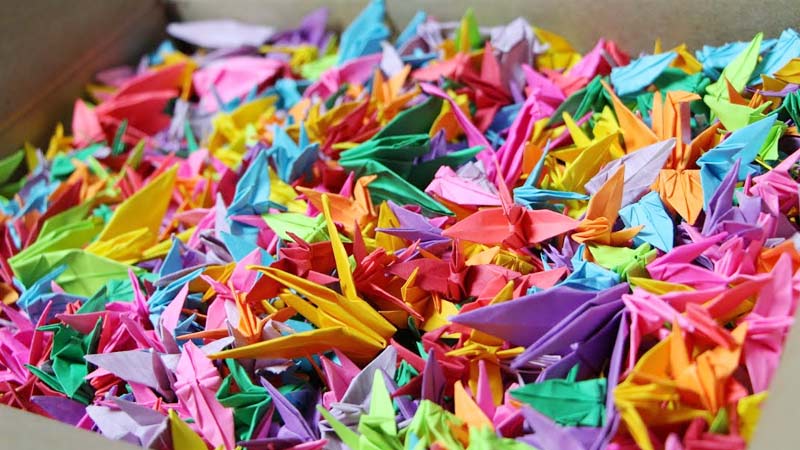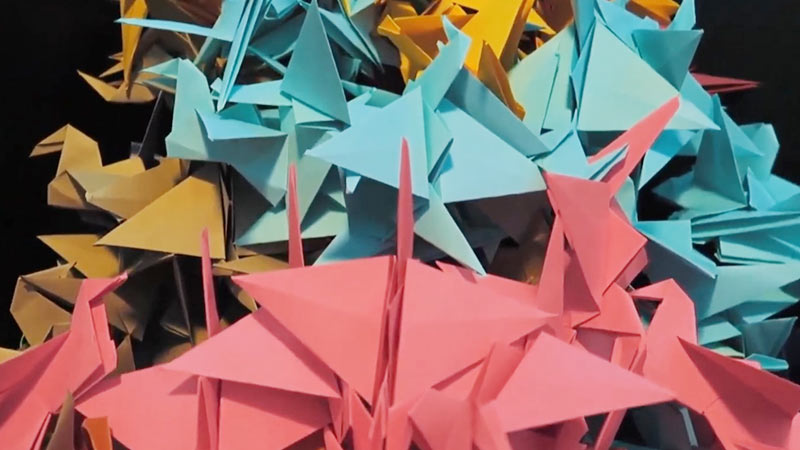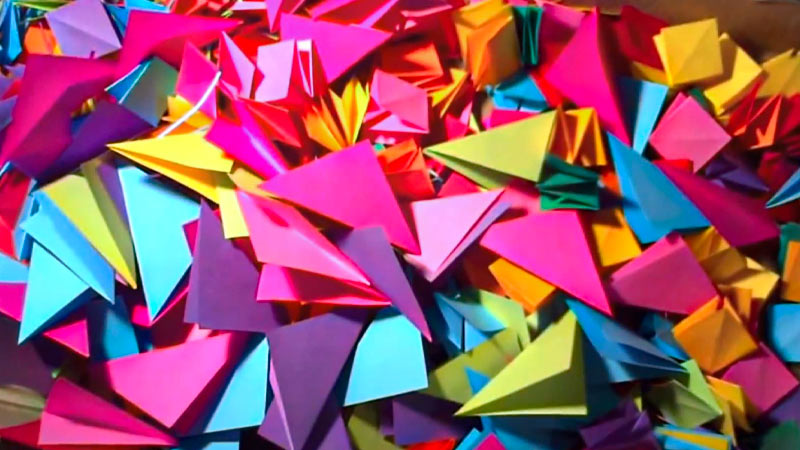In the delicate world of origami, a single-folded crane symbolizes grace and beauty. Yet, when one embarks on the intricate journey of crafting a thousand origami cranes, this art form transcends aesthetics, carrying profound meaning and cultural significance.
Folding 1,000 origami cranes, known as a Senbazuru, is an ancient Japanese tradition with roots that run deep in folklore and history.
Beyond the meticulous craftsmanship, this practice embodies hope, resilience, and a collective yearning for peace.
The story of Sadako Sasaki, a young survivor of the Hiroshima atomic bombing, further underscores the transformative power of these delicate paper birds.
In this exploration, we delve into what 1,000 origami cranes truly mean, unraveling their rich symbolism and universal appeal.

What Does 1000 Origami Cranes Mean?
Origami, the intricate Japanese art of paper folding, encompasses a rich tapestry of symbolism. Among its myriad creations, the origami crane stands out as a potent symbol of hope, peace, and resilience.
However, when one folds 1,000 origami cranes, the practice takes on profound significance, and it becomes known as a Senbazuru.
Historical and Cultural Roots
The tradition of folding 1,000 origami cranes has deep cultural roots in Japan. The crane, known as “tsuru” in Japanese, occupies a unique place in Japanese folklore and tradition.
This elegant bird is not only associated with longevity but is also believed to live for a thousand years. Furthermore, it is regarded as a symbol of good fortune and happiness, making it an enduring emblem in Japanese culture.
Sadako Sasaki and the Hiroshima Connection
The poignant story of Sadako Sasaki, a young Japanese girl who survived the devastation of the Hiroshima atomic bombing in 1945, played a pivotal role in popularizing the practice of folding 1,000 cranes.
Tragically, Sadako developed leukemia as a result of her exposure to radiation. While confined to her hospital bed, she came across an ancient Japanese legend that promised a wish granted to anyone who folded 1000 paper cranes. Her wish was simple yet profound: to regain her health.
A Symbol of Hope and Unity

Sadako’s fervent determination to fold 1,000 cranes as a path to recovery remains a testament to the power of hope and resilience. Although she tragically passed away before completing her Senbazuru, her story touched the hearts of many.
In a heartwarming display of solidarity, her friends and classmates took up the task of folding the remaining cranes, honoring her memory and her unwavering hope.
Beyond Borders: A Global Symbol
The practice of folding 1,000 origami cranes has transcended its Japanese origins to become a symbol of peace and unity worldwide.
People from diverse backgrounds now fold cranes to commemorate special occasions, advocate for peace, or raise awareness for various causes.
This meditative and mindful practice fosters patience, creativity, and focus while embodying the universal desire for peace.
The Power of Intention
The essence of 1,000 cranes lies not only in the physical act of folding but also in the intention behind it. Those who dedicate the time and effort to fold 1,000 cranes express a profound commitment to a cause, a heartfelt wish for healing, or a fervent desire for peace.
Each crane becomes a tangible symbol of hope, and the collective effort of folding 1,000 cranes carries a potent message of unity and positive transformation.
What to Do With 1000 Paper Cranes?

Once you have folded 1,000 paper cranes, you have created what is known as a Senbazuru, a powerful symbol of hope, peace, and resilience.
There are several meaningful and culturally significant ways to use or display your Senbazuru:
Gift for Special Occasions
Folding 1,000 paper cranes and presenting them as a gift on significant life events adds a deeply personal and cultural touch to the occasion. It’s a unique way to express your best wishes for the recipient’s future.
For weddings, each crane can be individually labeled with the names of the bride and groom, creating a personalized and memorable keepsake.
Display for Personal Inspiration
Your completed Senbazuru can be a stunning display of artistry and meaning in your own home.
Hanging it in a prominent place, such as the living room or bedroom, offers a daily reminder of hope, resilience, and the beauty of the art of origami. It can be a source of inspiration during challenging times.
Donate to Charity
Hospitals, especially those caring for children, often appreciate donations of Senbazuru. These colorful cranes can provide comfort and hope to patients and their families during their stay.
Additionally, you can donate your Senbazuru to charitable organizations that support various causes, spreading the message of hope and peace.
Peaceful Memorial
To remember and honor loved ones who have passed away, you can create a peaceful memorial by displaying your Senbazuru in a serene setting.
This can be done in a home garden, at a memorial site, or in a place of worship. It serves as a poignant symbol of eternal peace and love.
Awareness and Fundraising
Senbazuru can be a powerful tool for raising awareness about social or environmental issues.
Display it at events, rallies, or fundraisers to convey a message of unity and positive change. You can also auction or sell individual cranes to raise funds for a specific cause.
Artistic Creations
Unleash your creativity by using the 1,000 cranes in art installations, mobiles, or sculptures. Artists often incorporate Senbazuru into their work as a means of expressing ideas and emotions.
The array of colors and the delicate nature of the cranes make them a versatile medium for artistic expression.
Educational and Cultural Events
Share the rich tradition of origami and the symbolism of Senbazuru at cultural exhibitions, educational workshops, or events.
This can foster an appreciation for Japanese culture and inspire others to explore the art of paper folding.
Environmental Statement
If environmental sustainability is a concern, consider using recycled or eco-friendly paper for your cranes.
This not only promotes awareness of environmental issues but also aligns the Senbazuru tradition with responsible practices. Hanging origami cranes from the ceiling can create a beautiful and enchanting display.
Here’s a step-by-step guide on how to do it:
Materials Needed:
- Origami cranes
- String or fishing line
- Small hooks or adhesive hooks
- Scissors
- Optional: beads, ribbons, or other decorative elements
Instructions:
Prepare Your Origami Cranes
Ensure that your origami cranes are properly folded and in good condition. You can use cranes of various colors or stick to a particular color scheme, depending on your preference.
Cut String or Fishing Line
Cut the string or fishing line into the desired lengths for hanging your cranes. The length depends on how far you want the cranes to hang from the ceiling. Typically, 12 to 18 inches (30 to 45 cm) works well, but you can adjust this to your liking.
Attach the String to Cranes
Carefully thread one end of the string through the small hole at the bottom of each crane (if your origami cranes have this feature). If there’s no hole, you can gently tape or glue the string to the crane’s underside.
Create a Pattern or Design
Before hanging the cranes, plan the layout and design. You can have the cranes evenly spaced in rows, create clusters, or have them hang at different heights for a dynamic effect. Experiment with different arrangements to achieve your desired look.
Install Hooks on the Ceiling
Install small hooks on the ceiling where you want to hang your origami cranes. The number of hooks depends on your display design. Ensure that the hooks are securely attached to the ceiling to support the weight of the cranes.
Hang the Cranes
Attach the other end of each string to the hooks on the ceiling. Ensure that the strings are taut and that the cranes hang at the desired height and arrangement. You may need a ladder or a helper to assist with this step.
Adjust and Balance
Step back and assess the display. Make any necessary adjustments to ensure that the cranes hang evenly and create the desired visual effect. You can also add decorative elements like beads or ribbons to the strings for extra flair.
Secure the Strings
Once you’re satisfied with the arrangement, you can secure the strings in place on the hooks. Use small knots, adhesive hooks, or clips to prevent the strings from slipping or getting tangled.
Enjoy Your Display
Step back and admire your hanging origami crane display. It will create a captivating and enchanting atmosphere in the room, adding a touch of elegance and symbolism to your space.
FAQS
How long does it take to fold 1,000 cranes?
Folding 1,000 cranes can vary greatly in terms of time depending on one’s experience, skill level, and dedication.
On average, it may take several weeks to a few months of consistent effort to complete a Senbazuru.
What are 1000 paper cranes used for?
1,000 paper cranes are often folded as a symbol of hope, healing, and peace. They can be used to convey well wishes, commemorate special occasions, or raise awareness for various causes.
Is there a traditional significance to the number 1,000 in origami cranes?
Yes, in Japanese culture, the number 1,000 is considered significant and is associated with good luck, longevity, and the granting of wishes.
Are there alternative methods for achieving the same symbolic significance as folding 1,000 origami cranes?
Yes, there are other symbolic practices and rituals in various cultures that convey similar messages of hope, peace, and healing.
Are there any superstitions or beliefs associated with the number 1,000 in origami cranes?
In Japanese culture, the number 1,000 is often seen as a symbol of completeness and good fortune.
To Recap
In the delicate art of origami, the 1,000 origami cranes, known as Senbazuru, form a tapestry of profound meaning. Beyond the meticulous craftsmanship lies a symbol of hope, resilience, and unity.
This ancient Japanese tradition has transcended its cultural origins to become a universal language of peace, healing, and goodwill.
The story of Sadako Sasaki, whose unwavering spirit amidst adversity kindled the practice’s popularity, underscores the transformative power of these fragile paper birds.
Folding 1,000 cranes is a reminder that even in the face of challenges, dedication, and collective effort can bring about positive change.
It stands as a testament to the enduring human longing for a world imbued with hope and harmony.
Leave a Reply